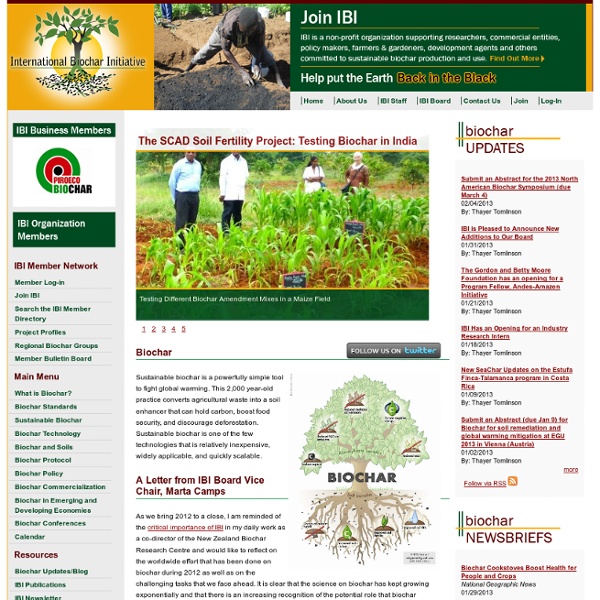



http://www.biochar-international.org/
Related: Permaculture • BiocharBiochar Biochar created through the pyrolysis process. History[edit] Left - a nutrient-poor oxisol; right - an oxisol transformed into fertile terra preta using biochar Pre-Columbian Amazonians are believed to have used biochar to enhance soil productivity. They produced it by smoldering agricultural waste (i.e., covering burning biomass with soil)[5] in pits or trenches.[6] European settlers called it terra preta de Indio.[7] Following observations and experiments, a research team working in French Guiana hypothesized that the Amazonian earthworm Pontoscolex corethrurus was the main agent of fine powdering and incorporation of charcoal debris to the mineral soil.[8] The term “biochar” was coined by Peter Read to describe charcoal used as a soil improvement.[9]
Make Biochar — This Ancient Technique Will Improve Your Soil Last year, I committed one of the great sins of gardening: I let weeds go to seed. Cleaning up in fall, I faced down a ton of seed-bearing foxtail, burdock and crabgrass. Sure, I could compost it hot to steam the weed seeds to death, but instead I decided to try something different. I dug a ditch, added the weeds and lots of woody prunings, and burned it into biochar, thus practicing a “new” soil-building technique that’s at least 3,000 years old. Soil Soil is the mixture of minerals, organic matter, gases, liquids and a myriad of micro- and macro- organisms that can support plant life. It is a natural body that exists as part of the pedosphere and it performs four important functions: it is a medium for plant growth; it is a means of water storage, supply and purification; it is a modifier of the atmosphere; and it is a habitat for organisms that take part in decomposition and creation of a habitat for other organisms. Soil is considered the "skin of the earth" with interfaces between the lithosphere, hydrosphere, atmosphere, and biosphere.[1] Soil consists of a solid phase (minerals & organic matter) as well as a porous phase that holds gases and water.[2][3][4] Accordingly, soils are often treated as a three-state system.[5] Overview[edit] Soil is a major component of the Earth's ecosystem. Soils can effectively remove impurities, kill disease agents, and degrade contaminants.
Tree Disease identification, symptoms, treatment options for tree diseases There are many different diseases that affect landscape trees and shrubs. Control of tree and shrub diseases cannot be properly accomplished until the disease pest is identified. Identification of tree and shrub diseases is crucial because, although most diseases can be controlled, there are some diseases that cannot be controlled. Disease control on landscape trees and shrubs can sometimes be accomplished by more than one method, depending on the particular disease that if infecting your landscape plants. Fungicides are often used to control diseases on landscape trees and shrubs and fungicides may be sprayed, injected into the tree trunk, or even injected into the soil surrounding the roots of the tree or shrub. In other cases cultural changes, such as tree pruning, tree fertilization, or altering watering habits, may reduce disease infection on landscape trees and shrubs.
How to Improve Garden Soil With Charcoal If you want to raise rich, lush flowers and vegetables in your garden, adding charcoal to the soil is a simple and effective method. There are many reasons to add charcoal to your garden, including raising the soil’s pH, improving air circulation and increasing the soil’s ability to retain water and nutrients. Once added, the benefits of charcoal continue for years. Should you decide to sell your home, the charcoal-aided garden can help it stand out from neighboring yards. If you don’t plan on moving, each year you can enjoy the benefits that this simple measure brings.
Permaculture (How to Design Systems for Sustainable, Community Living) – Bill Mollison « Only Ed Posted16 September 2011, by Staff, Sterling Insights, sterlinginsights.com Permaculture (permanent agriculture/culture) is the use of Ecology as the basis for designing integrated systems of food production, housing, technology, & community development. The objective is to produce an efficient, low-maintenance, productive integration of plants, structures & people, to obtain on-site stability & food self-sufficiency in the smallest practical area.
Tree Encyclopedia Trees have three principle features that distinguish them from all other plants. First, they have a woody stem, roots and branches which do not die back in winter, but continue to grow year after year. From the moment of its germination, a tree remains visible; from the tallest Sequoia to the smallest garden fruit tree, this principle of growth remains constant. Trees live longer than any other organism on earth.
BIOCHAR – Wydział Inżynierii Produkcji i Logistyki About biochar - BIOCHAR - Wydział Inżynierii Produkcji i Logistyki Biochar is a carbon product (as charcoal) produced from the organic waste in the process of pyrolysis. Currently, a range of biochar-related research are being conducted worldwide. Moreover, a number of companies and non-profit organizations related to this topic have been established. Research areas focused on biochar can generally be divided into three groups: Start a 1-Acre, Self-Sufficient Homestead - Modern Homesteading Everyone will have a different approach to keeping a self-sufficient homestead, and it’s unlikely that any two 1-acre farms will follow the same plan or methods or agree completely on how to homestead. Some people like cows; other people are afraid of them. Some people like goats; other people cannot keep them out of the garden. Some people will not slaughter animals and have to sell their surplus stock off to people who will kill them; others will not sell surplus stock off at all because they know that the animals will be killed; and still others will slaughter their own animals to provide their family with healthy meat. For myself, on a 1-acre farm of good, well-drained land, I would keep a cow and a goat, a few pigs and maybe a dozen hens. The goat would provide me with milk when the cow was dry.